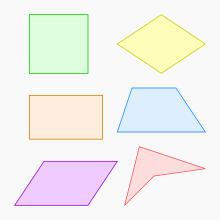polygon with four sides From Wikipedia, the free encyclopedia
In Euclidean plane geometry, a quadrilateral is a polygon with four edges (or sides) and four vertices (or corners). Sometimes, the term quadrangle is used (similar to the term "triangle"), while other times, the term tetragon is used (similar to pentagon, 5-sided polygon, and hexagon, 6-sided polygon). A quadrilateral with vertices , , , is sometimes written as .[1][2][3]
| Quadrilateral | |
|---|---|
 Some types of quadrilaterals | |
| Edges and vertices | 4 |
| Schläfli symbol | {4} (for square) |
| Area | various methods, usually base time height |
| Internal angle (degrees) | 90° (for square and rectangle) |

The origin of the word quadrilateral is the two Latin words quadri, a variant of four, and latus, meaning "side".
Quadrilaterals can be either complex, also called crossed (self-intersecting), or simple (not self-intersecting). Simple quadrilaterals are either convex or concave.
All the sides of a quadrilateral are straight, and the interior angles of a quadrilateral add up to 360°.[3]
This is a special case of the n-gon interior angle sum formula: (n − 2) × 180°.
All non-self-crossing quadrilaterals tile the plane, by repeated rotation around the midpoints of their edges.
There are 6 special kinds of quadrilaterals; square, rectangle, rhombus, parallelogram, kite, and trapezoid. Technically, squares, rectangles, and rhombuses are types of parallelograms.[3]
Seamless Wikipedia browsing. On steroids.
Every time you click a link to Wikipedia, Wiktionary or Wikiquote in your browser's search results, it will show the modern Wikiwand interface.
Wikiwand extension is a five stars, simple, with minimum permission required to keep your browsing private, safe and transparent.